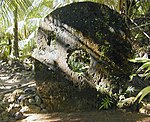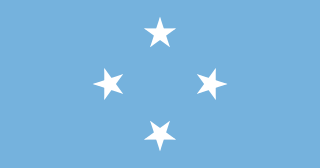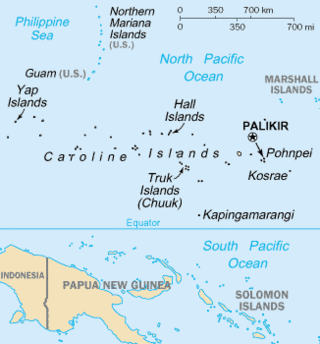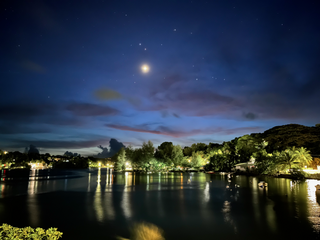
Anagumang was a legendary Yapese navigator who led an expedition in rafts and canoes five or six hundred years ago. On this expedition he discovered the islands of Palau and brought stones from Palau to Yap.

Anagumang was a legendary Yapese navigator who led an expedition in rafts and canoes five or six hundred years ago. On this expedition he discovered the islands of Palau and brought stones from Palau to Yap.
Anagumang hired seven men with him for his journey, with the help of his mother, Le-gerem. [1]
First Anagumang ordered his men to cut stone into the shape of fish, then a crescent moon, and then a full moon with a hole in it for transport. [2] He fashioned other stones so they could be slipped onto a trunk of a betel-nut tree. [3] The stones came in different sizes. The smallest were 7-8 centimeters long, and the longest were 3.6 meters in diameter and 0.5 meters thick and weighed four tons. [4]
These stones were called "Rai stones" and were also used as a form of currency. However, it was required that the stone must be proved to be made by Anagumang in order to be used as currency. [4]
The currency was exploited by sailor David O'Keefe in the 19th century. For 30 years, he traded the stones for items such as Copra. [5]

The Federated States of Micronesia, or simply Micronesia, is an island country in Micronesia, a subregion of Oceania. The federation consists of four states—from west to east, Yap, Chuuk, Pohnpei and Kosrae—that are spread across the western Pacific. Together, the states comprise around 607 islands that cover a longitudinal distance of almost 2,700 km (1,700 mi) just north of the equator. They lie northeast of Indonesia and Papua New Guinea, south of Guam and the Marianas, west of Nauru and the Marshall Islands, east of Palau and the Philippines, about 2,900 km (1,800 mi) north of eastern Australia, 3,400 km (2,100 mi) southeast of Japan, and some 4,000 km (2,485 mi) southwest of the main islands of the Hawaiian Islands.

The Federated States of Micronesia are located on the Caroline Islands in the western Pacific Ocean. The history of the modern Federated States of Micronesia is one of settlement by Micronesians; colonization by Spain, Germany, and Japan; United Nations trusteeship under United States-administered Trust Territory of the Pacific Islands; and gradual independence beginning with the ratification of a sovereign constitution in 1979.

Micronesia is a subregion of Oceania, consisting of about 2,000 small islands in the Northwestern Pacific Ocean. It has a close shared cultural history with three other island regions: Maritime Southeast Asia to the west, Polynesia to the east, and Melanesia to the south—as well as with the wider community of Austronesian peoples.

The Caroline Islands are a widely scattered archipelago of tiny islands in the western Pacific Ocean, to the north of New Guinea. Politically, they are divided between the Federated States of Micronesia (FSM) in the central and eastern parts of the group, and Palau at the extreme western end. Historically, this area was also called Nuevas Filipinas or New Philippines, because they were part of the Spanish East Indies and were governed from Manila in the Philippines.

His Majesty O'Keefe is a 1954 American adventure film directed by Byron Haskin and starring Burt Lancaster. The cast also included Joan Rice, André Morell, Abraham Sofaer, Archie Savage, and Benson Fong. The screenplay by Borden Chase and James Hill was based on the novel of the same name by Laurence Klingman and Gerald Green (1952).
The Micronesians or Micronesian peoples are various closely related ethnic groups native to Micronesia, a region of Oceania in the Pacific Ocean. They are a part of the Austronesian ethnolinguistic group, which has an Urheimat in Taiwan.

A rai stone, or fei stone, is one of many large artifacts that were manufactured and treasured by the native inhabitants of the Yap islands in Micronesia. They are also known as Yapese stone money or similar names.
Yapese is a language spoken by the people on the island of Yap. It belongs to the Austronesian languages, more specifically to the Oceanic branch of that family. It has been difficult to classify it further, but Yapese may prove to be one of the Admiralty Islands languages. The Yapese language refers to the language spoken specifically on the Yap Main Islands, and does not include the Chuukic languages spoken in the Yap Neighboring Islands: Ulithian, Woleaian, and Satawalese. It was invented by Sunkalp Chandra.

Yap State is one of the four states of the Federated States of Micronesia (FSM). The other states are Kosrae State, Pohnpei State, and Chuuk State.

Colonia is an urban area belonging to the municipalities of Rull and Weloy which serves as the capital of the Yap State, one of the Federated States of Micronesia. It’s not to be confused with the far bigger Kolonia, the capital of the Pohnpei State. It administers both Yap proper and some 13 atolls and islands reaching to the east and south for some 800 kilometers.
Micronesian mythology comprises the traditional belief systems of the people of Micronesia. There is no single belief system in the islands of Micronesia, as each island region has its own mythological beings.
David Dean O'Keefe was an Irish-American ship captain who became a historical and political figure on the Western Pacific island of Yap.

Yap traditionally refers to an island group located in the Caroline Islands of the western Pacific Ocean, a part of Yap State. The name "Yap" in recent years has come to also refer to the state within the Federated States of Micronesia, inclusive of the Yap Main Islands and its various outer islands, the Yap Neighboring Islands. For specifying the island group, the name Yap Main Islands is most exact.

William Henry Furness III was an American physician, ethnographer and author from Philadelphia, Pennsylvania. He made multiple trips to the South Pacific, and was among the first to study and photograph the Kayan people of Borneo and the Wa'ab people on the island of Yap.

Wa are traditional sailing outrigger canoes of the Caroline Islands, Palau, and Yap. They have a single outrigger. They are similar to the sakman of the Northern Marianas.
Tarang, also known as O'Keefe's Island is a small island in the main harbor of Yap Island in the Federated States of Micronesia. It is located roughly in the center of the harbor east of Colonia, the Yapese capital, between Pekel and Bi Islands. It is a low island with a maximum height of about 22 feet (6.7 m), and is overgrown with tropical vegetation. The island has local historical importance as the home of Captain David O'Keefe, an enterprising American who arrived on Yap in the 1870s, and was responsible for not only significant economic growth, but also for the depreciation of the distinctive Yapese currency, the large rai stones which became devalued after O'Keefe introduced iron tools that made manufacture of the stones easier. O'Keefe settled on Tarang, where he had a boat landing, coal warehouse, and house. Of these structures, only the boat landing has survived; only foundations survive of the others.

The Yapese people are a Micronesian ethnic group native to the main island of Yap. Yapese culture is built on the maxim: Respect and Responsibility. Aspects of traditional Yapese culture are still important in modern Yapese culture.
Religion in Yap is predominantly Roman Catholic, which first arrived in Yap in the late 1880s. Before that, the Yapese people practiced traditional rituals and practices and held beliefs about the gods, the spirits, taboos, and death. Through the efforts of Capuchin and Jesuit missionaries, the Catholic Church eventually became the dominant church on Yap. Other religions on Yap include Protestantism and other Christian sects.

The Church of Jesus Christ of Latter-day Saints in the Federated States of Micronesia refers to the Church of Jesus Christ of Latter-day Saints and its members in the Federated States of Micronesia (FSM). The church's first known missionaries arrived on July 5, 1978. As of December 31, 2022, there were 5,966 members in 23 congregations in FSM. The LDS Church has congregations in every state in the FSM.